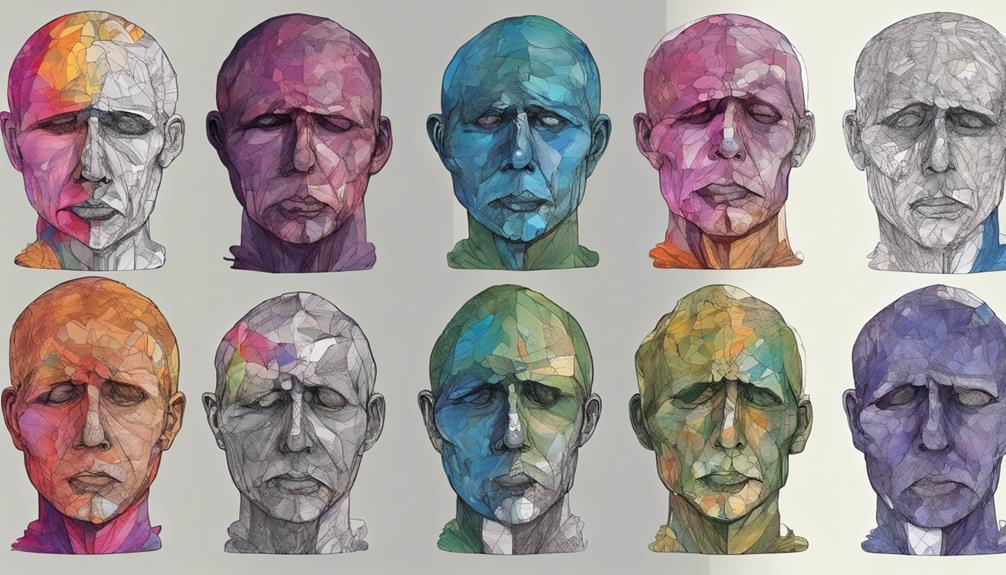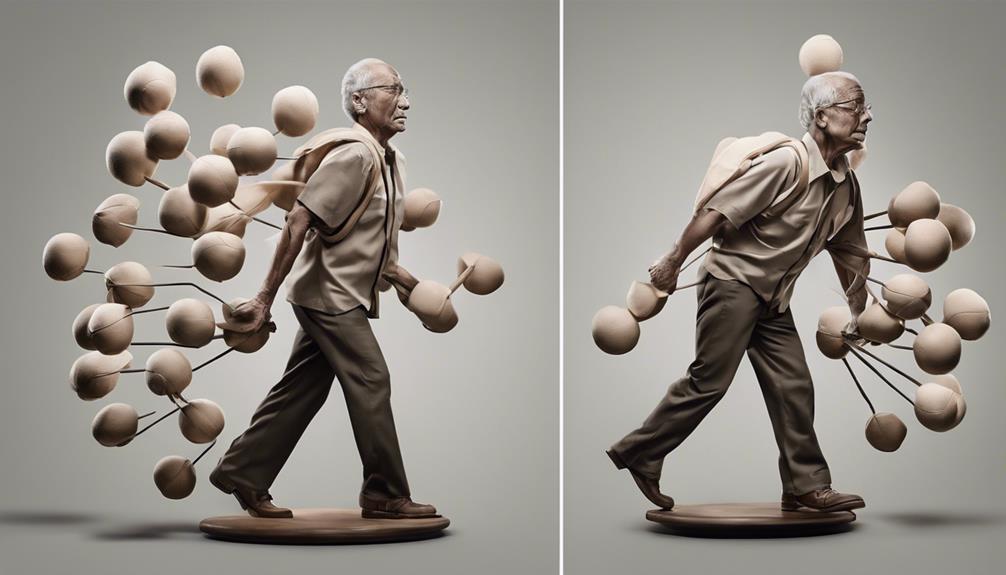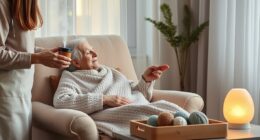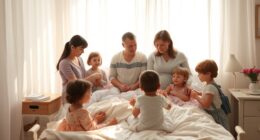To effectively avoid falls, prioritize engaging in regular exercise. Improve muscle strength and coordination by participating in activities such as strength and balance training. Ensure that your home is well-lit to see clearly and eliminate any tripping hazards. Regularly check your vision to identify poor eyesight early on. Install grab bars in your bathroom and utilize assistive devices for additional support. By taking these measures, you can uphold your independence and quality of life. Find additional tips on preventing falls by referring to our comprehensive guide.
Key Takeaways
- Regular exercise enhances muscle strength and coordination.
- Ensure proper lighting and remove tripping hazards at home.
- Implement preventive measures like grab bars and assistive devices.
- Address home-related risk factors to reduce accidents.
- Maintain independence through lifestyle changes and home modifications.
Importance of Fall Prevention
Fall prevention is essential for the well-being and safety of older adults, greatly reducing the risk of injuries and healthcare costs associated with falls. Prevention measures encompass various strategies aimed at creating a safe environment and promoting overall health and well-being in older individuals.
Regular exercise, such as strength and balance training, plays a pivotal role in fall prevention by enhancing muscle strength and coordination, thereby improving stability and reducing the likelihood of falls. Additionally, ensuring proper lighting at home and removing tripping hazards like loose rugs or clutter can markedly decrease the risk of accidents.
Regular vision check-ups are also crucial, as poor eyesight can contribute to falls. Installing grab bars in bathrooms and using assistive devices like walking canes or walkers further support fall prevention efforts. By implementing these preventive measures, older adults can maintain their independence and enjoy a higher quality of life while reducing the risk of falls and associated injuries.
Understanding Risk Factors
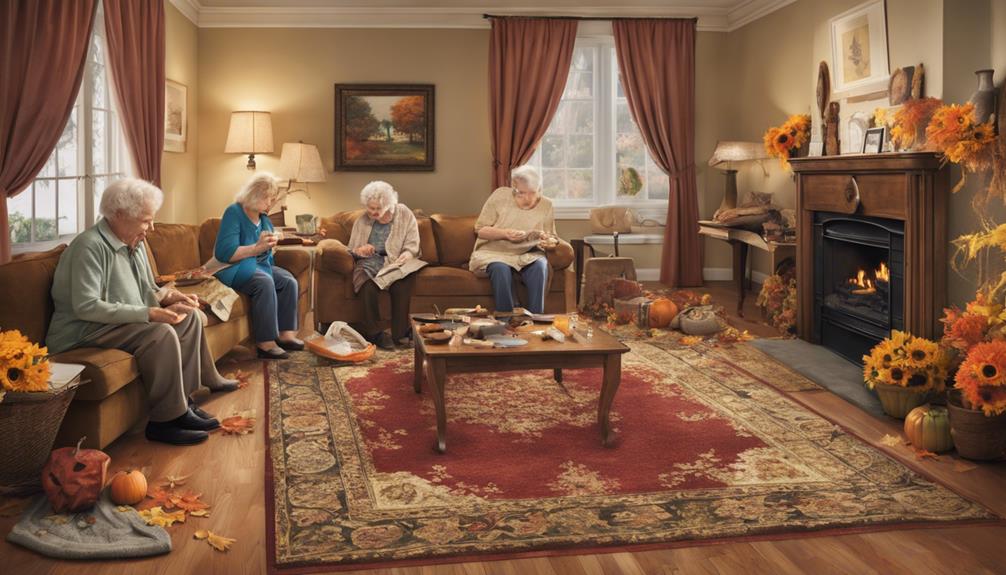
Understanding the risk factors associated with falls is essential for implementing effective prevention strategies and promoting the safety and well-being of older adults. Home-related risk factors play a significant role in increasing the likelihood of falls among the elderly. Slippery surfaces, such as wet floors or loose rugs, can pose a serious hazard. Poor lighting within the home can also contribute to falls, especially during nighttime when visibility is limited. It's vital to address these environmental factors to create a safer living space for older adults.
Additionally, most fractures among the elderly occur at home during daily activities, highlighting the importance of home safety measures. By identifying and addressing home-related risk factors, we can notably reduce the chances of falls and their associated injuries. Simple modifications like installing grab bars, removing clutter, and ensuring proper lighting can make a substantial difference in preventing falls within the home. Prioritizing home safety is key to promoting the overall well-being and independence of older adults.
Lifestyle Changes for Prevention
When considering strategies to prevent falls, incorporating lifestyle changes can greatly enhance overall safety and well-being for older adults.
Annual eye examinations play an important role in identifying vision issues that may increase fall risk.
Maintaining a diet rich in calcium and Vitamin D is essential for supporting bone health, reducing the risk of fractures from falls among seniors.
Starting an exercise program focusing on strength and balance can greatly improve stability, preventing falls.
It's important for older adults to wear properly fitting shoes with nonskid soles to enhance traction and minimize the risk of slipping or tripping.
Additionally, placing essential items like lamps, telephones, or flashlights near the bed promotes safety and accessibility in case of nighttime falls.
Home Modifications for Safety

One effective way to enhance safety and reduce the risk of accidents at home is by implementing modifications that prioritize stability and support. Installing grab bars in bathrooms and near stairs can greatly reduce the risk of falls by providing individuals with a secure handhold.
Essential lighting throughout the home is vital, especially at night, to help individuals navigate their surroundings safely. Removing tripping hazards such as loose rugs and clutter can greatly decrease the chances of accidental falls.
Non-slip mats in the bathroom and shower are critical for preventing slips on wet surfaces, adding an extra layer of safety. Home modifications like grab bars and non-slip mats are particularly effective for older adults, promoting independence and reducing the likelihood of falls.
Exercising for Fall Prevention
Regular exercise is essential for preventing falls among older adults. Strength training helps build muscle. Balance exercises improve stability. Flexibility enhances coordination.
Strength Training Benefits
Strength training enhances muscle mass, strength, and balance, crucial for reducing the risk of falls in older adults. Regular strength training exercises, like squats and lunges, improve stability and coordination, helping prevent falls.
Studies suggest that engaging in strength training can reduce the incidence of falls by up to 40% in older individuals. This form of exercise, done 2-3 times a week, not only enhances bone density but also reduces the likelihood of fractures from falls.
Strengthening muscles through resistance training enables older adults to maintain independence and confidence in daily activities, ultimately lowering their risk of falls. Remember, a consistent strength training routine can greatly benefit overall health and well-being, contributing to a safer and more active lifestyle.
Balance Exercises Importance
Improving balance through specific exercises is key to reducing the risk of falls in older adults. Health care providers recommend engaging in regular balance exercises to enhance muscle strength, stability, and coordination, ultimately preventing falls.
Activities like standing on one leg or practicing heel-to-toe walking are effective in improving balance. Balance training programs have demonstrated success in decreasing the rate of falls among elderly populations. By incorporating these exercises into daily routines, older adults can notably improve their overall balance and reduce the likelihood of experiencing a fall.
Health care professionals emphasize the importance of balance exercises as a proactive measure to maintain stability and prevent falls in older individuals.
Flexibility for Stability
To enhance stability and reduce the risk of falls, incorporating flexibility exercises into daily routines is essential. Flexibility exercises improve range of motion, balance, and joint stability, all of which contribute to preventing falls. By engaging in stretching routines regularly, one can enhance muscle flexibility and maintain agility, reducing the chances of accidents. Flexibility training is particularly beneficial for older adults as it helps them stay nimble and coordinated, factors vital for fall prevention. Regular stretching activities also decrease muscle stiffness, increase mobility, and promote overall physical well-being. Below is a table illustrating some simple flexibility exercises that can be incorporated into your daily routine:
| Flexibility Exercise | Description | Benefits |
|---|---|---|
| Hamstring Stretch | Sit and reach for toes, hold for 30s | Improved flexibility in the legs |
| Shoulder Stretch | Cross one arm over the body | Enhances shoulder mobility |
| Calf Stretch | Lean against a wall, stretch calves | Increases lower leg flexibility |
Proper Footwear Choices
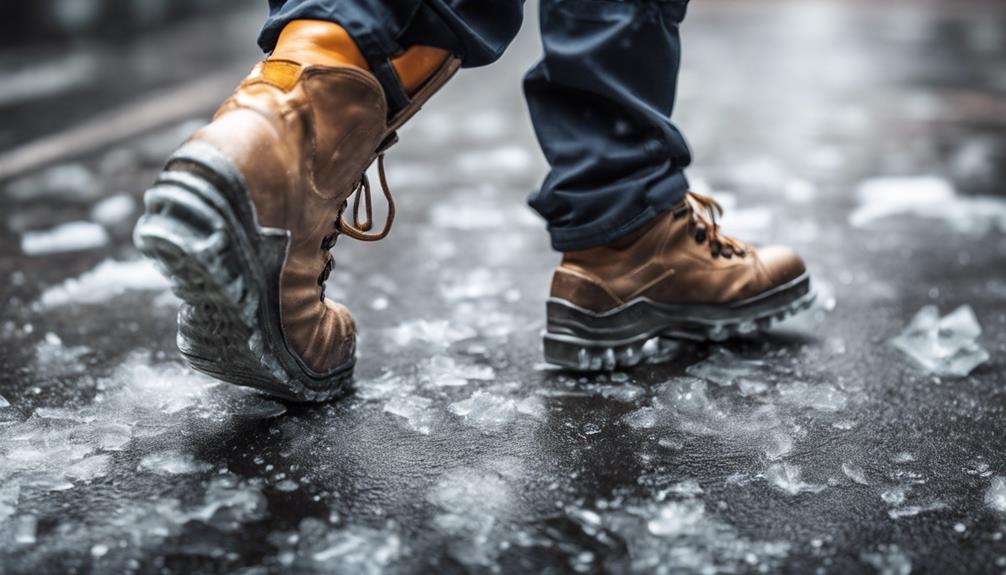
When considering fall prevention, selecting shoes with proper fit and support is essential. Footwear plays an important role in reducing the risk of falls. Opt for shoes with nonskid soles to improve traction and stability while walking on different surfaces.
Avoid high heels, flip flops, and worn-out shoes as they can increase the likelihood of slipping or tripping. It's important to choose shoes that provide good arch support and cushioning for comfort and safety. Regularly check your shoes for signs of wear and replace them when needed to maintain safe and effective footwear for fall prevention.
Ensuring Safe Bedrooms
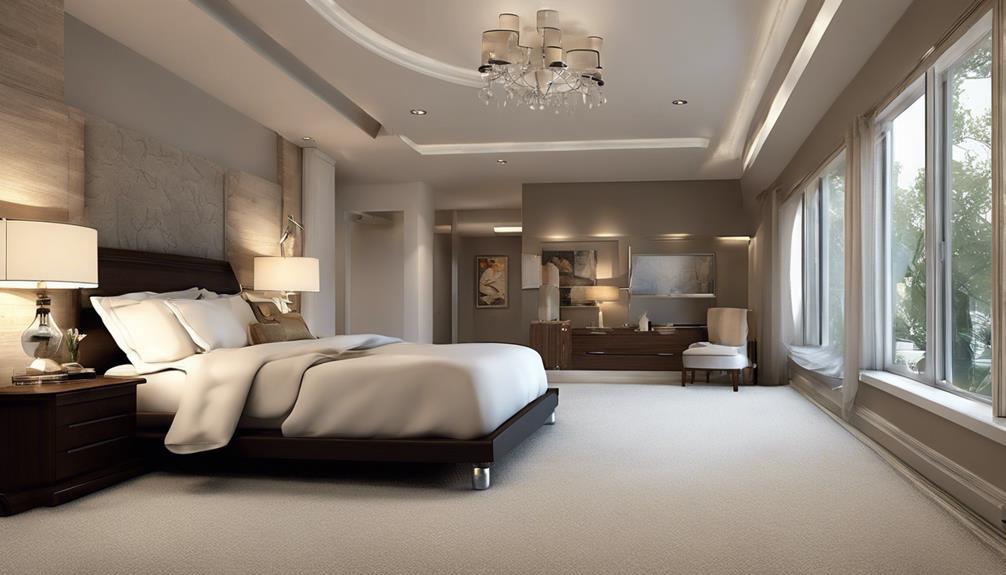
Moving from proper footwear choices to ensuring safe bedrooms, let's focus on practical ways to reduce the risk of falls within the bedroom environment. Here are some essential tips for ensuring a safe bedroom:
- Night Lights and Switches: Place night lights and switches near the bed to enhance visibility, especially during the night, reducing the chances of tripping or falling.
- Emergency Essentials: Keep a flashlight and phone within easy reach to aid in emergencies or when moving around in the dark, promoting safety and swift access to help.
- Clear Walking Paths: Maintain a clutter-free bedroom by removing obstacles that could cause tripping hazards, ensuring a safe and unobstructed walking path.
- Grab Bars: Install grab bars on both sides of the bed or within the bedroom to offer support and stability when getting in and out of bed, promoting independence and safety.
Creating Hazard-Free Living Spaces

To create hazard-free living spaces, we must make sure that walkways and floors are clear of any obstacles that could cause tripping.
Important lighting installation is vital in all areas of the home to enhance visibility and reduce the risk of falls.
Clear Walkways and Floors
Ensuring clear walkways and floors in our living spaces is essential for preventing falls and maintaining a safe environment. Here are some tips to help keep your floors hazard-free:
- Place light switches at the ends of stairs for better visibility.
- Keep walking areas tidy and free of obstacles to minimize tripping hazards.
- Secure carpets firmly to the floor to prevent slipping accidents.
- Avoid using throw rugs or walking on slippery floors to reduce the risk of falls.
Proper Lighting Installation
Properly installing lighting in living spaces greatly reduces the risk of falls by illuminating pathways and potential hazards. Motion-sensor lights near stairs and hallways guarantee visibility during nighttime movements, preventing accidents.
In bathrooms, the use of night lights or automatic sensors enhances safety for nighttime visits. Bedrooms with accessible switches and night lights help prevent falls during activities in the dark.
Strategic placement of lamps near potential fall zones like kitchen countertops improves visibility and diminishes fall risks. Ensuring adequate lighting in all living spaces not only creates a welcoming atmosphere but also plays an important role in preventing falls.
Bathroom Safety Measures
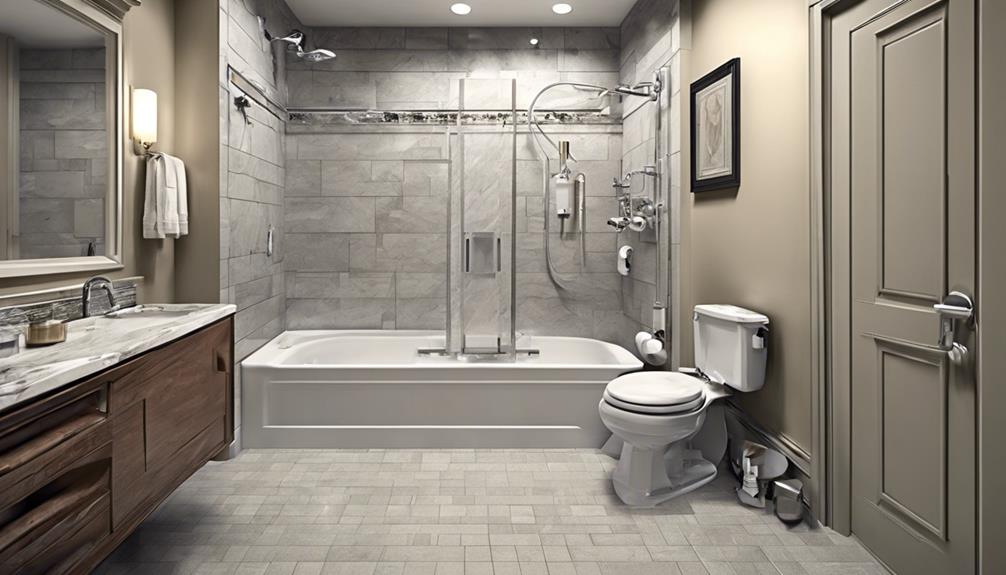
Implementing bathroom safety measures is vital for reducing the risk of falls and promoting independence in daily activities. Here are four essential steps to enhance safety in the bathroom:
- Mount grab bars: Installing sturdy grab bars near toilets and tubs provides support and stability, reducing the likelihood of falls, especially for older adults.
- Use nonskid mats or strips: Placing nonskid mats or strips on wet surfaces like the shower or bathroom floor helps prevent slipping accidents, ensuring a safer environment.
- Keep adequate lighting: Keeping a night light on or using automatic night lights can greatly improve visibility during nighttime bathroom visits, reducing the risk of tripping or falling.
- Implement safety measures: Falls in the bathroom are common among older adults, but taking proactive steps like those mentioned above can help prevent injuries, promoting a safer and more independent daily routine.
Frequently Asked Questions
What Are the 5 P's of Fall Prevention?
Familiar with the 5 P's of fall prevention well – Program Planning, Development, Implementation, Evaluation, and Sustainability. They lead us in identifying needs, setting goals, recruiting participants, analyzing outcomes, and making program improvements for safer communities.
What Are the Guidelines for Preventing Falls?
To prevent falls, we prioritize safety by keeping spaces clutter-free, installing grab bars, and ensuring proper lighting. Regular exercise and balance training are key. We promote awareness, offer assistance, and support individuals in maintaining independence and well-being.
What Are the 4 P's of Fall Prevention?
Identifying the 4 P's of fall prevention is essential in designing effective programs: Program Planning, Development, Implementation, and Evaluation. By understanding these key components, we can create thorough strategies to prevent falls and promote safety.
What Are the 5 Key Steps in a Falls Risk Assessment?
In a falls risk assessment, we evaluate balance, gait, mobility, strength, medication, vision, cognition, and chronic conditions. We also check for environmental hazards. Using tools like the Timed Up and Go test guarantees an objective assessment.
How Can Preventing Falls at Home be Incorporated into In-Home Health Care Services?
Preventing falls at home is crucial for those receiving inhome health care services. Simple modifications like installing grab bars, removing tripping hazards, and providing mobility aids can greatly reduce the risk of falls. In-home caregivers can also offer assistance with activities to further ensure safety and well-being.
Conclusion
To sum up, preventing falls is essential for maintaining safety and independence. By understanding risk factors, making lifestyle changes, and implementing home modifications, we can significantly reduce the risk of falls.
Remember, safety starts with awareness and proactive measures. Are you prepared to take the necessary steps to prevent falls and protect yourself and your loved ones?



